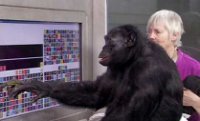Humans became human because of viruses
 Why do human beings and chimpanzees have the identical genome in spite of the fact that we are completely different creatures in our nature? Such a difference can not be based on mutations. Scientists have recently unveiled the mystery. It turned out that it all happened because of the viruses.
Why do human beings and chimpanzees have the identical genome in spite of the fact that we are completely different creatures in our nature? Such a difference can not be based on mutations. Scientists have recently unveiled the mystery. It turned out that it all happened because of the viruses.
It is an open secret that human beings and chimpanzees (Pan troglodytes) are close relatives in spite of the fact that they differ from each other greatly. Chimpanzees possess reasonable thinking, the skills for making labor tools, and the abilities for creating human-like languages. All of those abilities are embryonic. To put it otherwise, the predecessors of these two species had the same potential in the beginning of their evolution. Human beings managed to develop that potential, whereas chimpanzees could not.
It seems very intriguing that both human beings and chimpanzees are practically identical from the point of view of their genome. It was considered during the 1970s that the genes of the human being and the chimpanzee coincided on the level of 98.5 percent. The research in 2003 revealed that the extent of such coincidence is a lot higher - 99.6 percent. If it is so, then why do we differ so much from the point of view of the body structure and physiology?
Scientists originally believed that the difference appeared because of mutations in the DNA. However, the new research cast this version aside. The DNAs of the two species are practically identical. Why did the difference emerge then?
Scientists have several theories that shed light on this difficult question. One of them says that both human beings and chimpanzees possess different numbers of the copies of one and the same DNA parts. Many genes in the genome may exist in "singular and plural form." The more copies of a certain gene the molecule has, the more proteins cells produce. The information of those proteins is programmed in this certain gene. The amount of protein may exert a serious influence on the physiology and the body structure.
British researchers concluded that as much as ten percent of human-chimp identical genes differ on the number of copies represented in the genome. For example, the human CCL3L1 gene, unlike that of a chimp, is represented with a small number of copies. A human being only has three or four of such copies, whereas chimpanzees have dozens of them. Geneticists explain this with humans' hypersusceptibility to HIV, whereas this infection does not pose any danger to chimps - they do not suffer from AIDS. At the same time, chimpanzees have singular TBC1D3 gene, which takes part in the multiplication of cells. Human beings have eight copies of this gene.
Another theory that explains the difference between the "genetic twins" of humans and chimps says that even completely identical genes of the two species may function differently. Scientists wondered what happened during the evolution that caused such a phenomenon. A group of scientists chaired by John McDonald from Georgia Institute of Technology has unraveled the mystery. The scientists discovered that it all happened because of the "mobile" elements of the genome, known as retrotransposons.
From Wikipedia: Retrotransposons are genetic elements that can amplify themselves in a genome and are ubiquitous components of the DNA of many eukaryotic organisms. The retrotransposons' replicative mode of transposition through an RNA intermediate increases the copy numbers of elements rapidly and thereby can increase genome size. Like DNA transposable elements (class II transposons), retrotransposons can induce mutations by inserting near or within genes. Furthermore, retrotransposon-induced mutations are relatively stable, because the sequence at the insertion site is retained as they transpose via the replication mechanism.
Retrotransposons copy themselves to RNA and then back to DNA that may integrate back to the genome. The second step of forming DNA may be carried out by a reverse transcriptase which the retrotransposon encodes. Transposition and survival of retrotransposons within the host genome are possibly regulated both by retrotransposon- and host-encoded factors, to avoid deleterious effects on host and retrotransposon as well, in a relationship that has existed for many millions of years between retrotransposons and their plant hosts. The understanding of how retrotransposons and their hosts' genomes have co-evolved mechanisms to regulate transposition, insertion specificities, and mutational outcomes in order to optimize each other's survival is still in its infancy.
Retrotransposons are particularly abundant in plants. Seventy percent of the maize genome, for example, consists of retrotransposons. Fifty percent of the human genome consists of retrotransposons.
The US scientists compared the differently operating genes of the human being and the chimpanzee. They discovered that the difference of their activity is based on the presence of retrotransposons in close vicinity to genes. If they were present, the gene would either reduce or stop its activity. If there were no retrotransposons near the genes, they operated normally.
It just so happens that the difference between the human being and the chimpanzee did not occur because of mutations. It occurred because of the viruses that travel across the genome. The viruses changed the work of the genes and led to the differences between the appearance and the physiology of the closely related species.
It is not ruled out that humans look human, walk human and do many other human-like things owing to viruses. Those viruses penetrated into the genome of the mammals in the very beginning of their evolution. Their descendants subsequently provided the appearance of the only form of reasonable life on our planet.
Anton Yevseev
Pravda.Ru
Subscribe to Pravda.Ru Telegram channel, Facebook, RSS!





